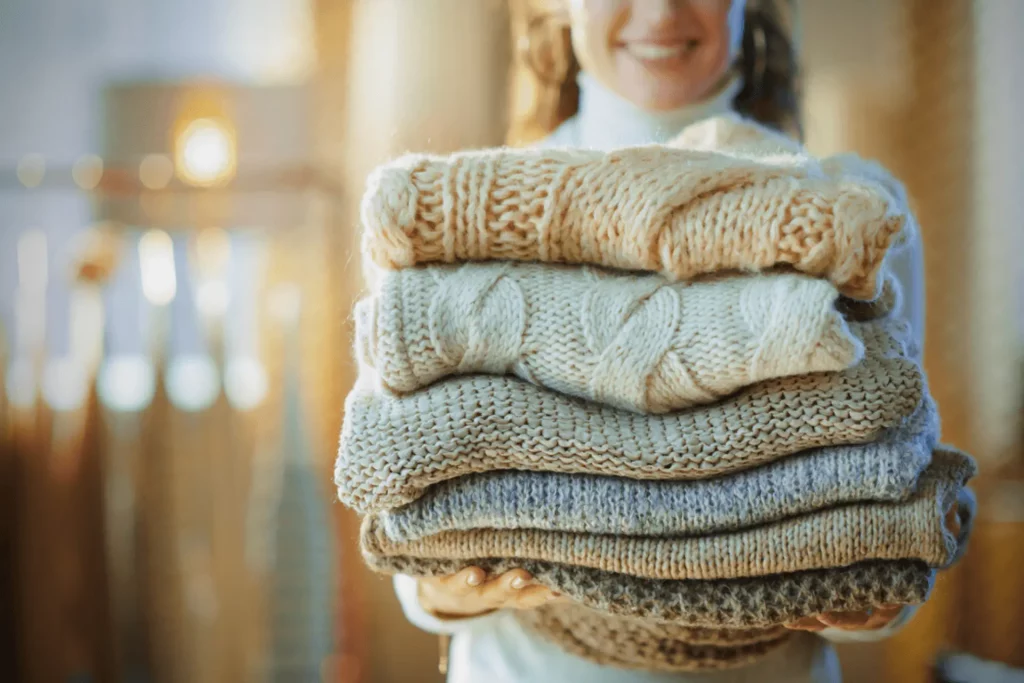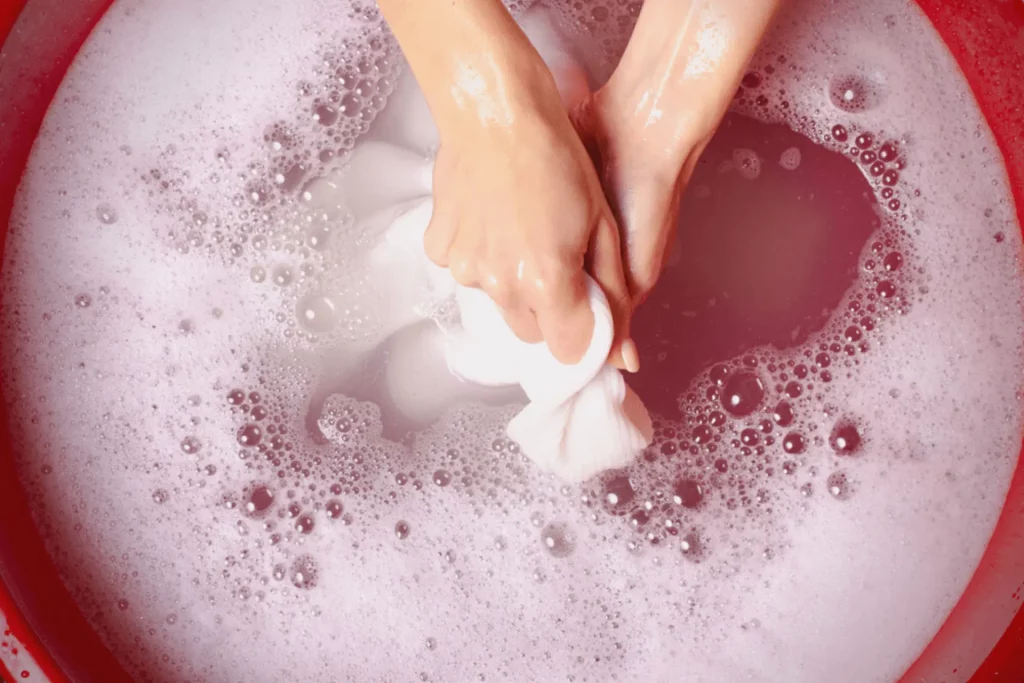It isn’t easy to understand cashmere. Many people will tell you that you have to wash it in a bowl, reshape it, scrunch it up, prevent it from stretching, and use special detergents… I concur that these techniques are the most effective ones for maintaining cashmere. On the other hand, we are all adult women who lead busy lives, and very few of us have the time or the patience to wash our delicates by hand.
However, this does not preclude the possibility of owning cashmere and maintaining its pristine appearance even after dozens upon dozens of wears. In the following paragraphs, I will explain how I effectively spot clean cashmere, refresh it between washes, and launder it at home. You will find this information helpful if you are short on time or patience.
Table of Contents
How Should a Cashmere Sweater Be Cleaned When Washed at Home in the Washing Machine?
- Discuss the best ways to take care of cashmere when you are short on time and patience… Did you know that your washing machine is a suitable washing method for cashmere? Now, I’m not suggesting that you wash your cashmere in the washing machine with your trousers and blankets, but you can wash cashmere in the machine in the same way that I do many of the things that I used to take to the dry cleaners.
- Put the cashmere sweater you’re washing in a mesh washing bag by itself. Because of the bag, a sleeve will not get trapped on the agitator or other items, preventing stretching.
- You should fasten the closure on your sweater if it has one. Zippers, snaps, and buttons—everything is fastened and secure. I always turn my cardigans inside out before washing them so the buttons won’t catch on anything else while they’re being laundered.
- Do the wash in the machine in a delicate setting. I recommend that if your washing machine has the capability, you choose full load but fill it at the halfway point with laundry so that everything has enough room to move about.
- I don’t spend much on detergent; it’s always liquid rather than powder when I purchase it. Because you are using the gentle cycle and cold water, there will be less turbulence, and I find that liquid is more beneficial than solid in this situation. At the moment, I’m very into Dirty Labs, a gentle yet effective laundry detergent that is also kind to the environment and those with allergies.
- Remove the cashmere from the machine and lay it on a bath towel to dry. Check to see if this bath towel is either a light color or white or that it has been washed so frequently that the color will not rub out.
- Make sure there are no creases in your sweater by smoothing it out. Make it look like you’re about to put it away in a suitcase by crossing the sleeves over the front of the garment.
- Roll up the sweater while it’s still within the towel. This will remove any extra water from your sweater without causing any stretching or other damage to its shape. It is not unnecessary to be meticulous with this, and some people choose to forego this step entirely. It expedites the drying process of the sweater and reduces the likelihood that it may stretch while wet.
- Place face down to dry. If you want to avoid stretching out your cashmere sweater, pick a drying rack instead of a clothes hanger to dry it on. If you do not have access to a drying rack, you may put your sweater flat on a dry and clean towel and then turn it over after a few hours so that all sides can benefit from air circulation.
Advice on How to Properly Care For Cashmere Objects:
Use Dry Cleaning Only Judiciously:

Dry cleaning is undoubtedly an efficient method; nonetheless, I limit how frequently I use it on my cashmere. In addition to being prohibitively costly, it exacts a toll.
After a few trips to the dry cleaner, the cashmere sweater you own will never again be as supple as it was when you first bought it. When it comes to cleanliness, washing by hand is your best bet.
Do Your Laundry by Hand at Home:
I don’t wash my cashmere every time I wear it, apart from my cashmere socks, which can become a little bit disgusting. Other than that, though, I don’t wash it. When I do, though, I use the wool and cashmere wash that The Laundress sells. I have a small glass basin that I will place in the middle of my sink, and I will use cold water to hand-wash each item, except socks and other little objects.
You should most definitely use a detergent that is on the gentle side. I’ve had good results using the wool and cashmere shampoo, but I’ve also had success with The Laundress’s standard detergent. I have read that baby shampoo will also work, but I have to admit that I have never tried it myself!
After thoroughly combining the water and the detergent, squeeze and wring the clothing so that the soapy water may penetrate it.
It Has to Be Dried Flat:
After giving the item a quick rinse, squeeze out as much water as possible by pressing it. I prefer to place it on the floor of my bathtub so that any extra water can drain away, and then I’ll press down on it forcefully with the palms of my hands so that it can expel as much water as possible.
When the fabric has absorbed most of the water, I will spread out my pieces on a towel in a flat position and allow them to air dry. Before going to bed is the ideal time to do this; often, they will be dry in the morning!
This is significant because if you hang a garment made of cashmere after it has been wet, it will become stretched out and lose its form.
Treating Stains:

As with any stains, the most important thing is to cure them as soon as they occur!!! I take EXTREME PRECAUTIONS in removing stains from my cashmere sweaters. When I use the brush with this little kit, I find that a very small amount of the stain removal solution applied with the brush is needed to remove most stains.
I ensure to be cautious and kind and wash everything with ice water. After allowing the stain solution to gently permeate the cloth, use the brush to remove the stain from the fabric gently. Avoid rubbing!
How to Remove Those Pesky Wrinkles?
Because heat is wool’s mortal enemy, you should avoid using an iron because it mashes the fibers. Instead, go for a steamer to prepare the food.
According to Whiting, “some wools, such as a lighter merino or cashmere, are more likely to wrinkle after you wash them; in this case, you will need to steam.” She also enjoys using the steamer between washes as a quick pick-me-up for herself. The yarns are fluffier by steaming, which also acts as a natural refresher.
What Should I Do to Care For My Cashmere That Has a Slight Odor but is Otherwise Clean?
I feel that the fewer times you wash your clothes, the longer they will continue to be a treasured part of your wardrobe if your cashmere isn’t dirty but smells a little bit like your body, your food from the night before, or the smoky car that your relative drives, there’s no need to wash it to make it smell lovely again.
I give my cashmere sweaters quick steam after each wear. You can steam the wrinkly sections of the sweater (or the entire sweater) by using a portable steamer (this one is fantastic; it has worked for me on the trips and at home for a long), and then you can let it cool/dry in an area with adequate ventilation.
Do not hang it on a hanger like a regular top to allow it to air out; cashmere is prone to stretching, particularly when it is wet.
If you have a sweater that feels like something you don’t want to smell, you can do wonders by spraying it with a fabric freshening spray. I would advise you against using Febreeze on your sweaters.
The Laundress produces a delightful fabric refresher tailored particularly for sweaters and has a fragrance comparable to that of expensive perfume or cologne. It is not difficult to prepare your fabric refresher at home if the smell of that product is not to your liking.
How Should Cashmere Sweaters Be Stored?

You may wear our sweaters in any season thanks to the light weight of cashmere, which means you probably won’t let your clothing go missing for too long. If you decide to put your clothing away, you should make sure it is tidy before you do so. It is a common misconception that moths are drawn to cashmere itself; in reality, they are drawn to clothing that has been dirty or ruined.
We suggest you keep your cashmere sweater folded and stored in a bag that can be sealed again. Use natural ingredients such as clove, dried orange peel, rosemary, thyme, cedar, and lavender to ward off moths and insects.
Wrap these items in a cloth or a simple fabric sachet to prevent any stains from spreading to the clothing you are wearing. Cashmere sweaters should never be hung up to dry; instead, fold them to prevent the knit from becoming misshapen.
How Can I Prevent the Piling Up of Cashmere Sweaters?
We conduct tests at every production stage to guarantee that every John Smedley garment lives up to the highest possible performance standards. Several actions, including the following, can be done to assist in preventing pilling:
- After each wear, let the clothing have some time to rest.
- Wash and iron the garment inside out, as directed by the care instruction, to reduce the risk of contact with other textiles.
- Brushing it off can help get rid of any undesirable particles.
- Use detergents specifically formulated for cleaning cashmere when you wash it.
- A specialized dry cleaner is also an option for cleaning the clothing in this case.
Except for One Blemish, My Cashmere is Perfect! What is the Best Way to Clean Cashmere?

Even if I’m being extra careful, I’m going to spill something on my clothing since I’m a klutz. Because of this, I’ve honed my spot-removing skills into an art form. Baby shampoo works best for eliminating stains from cashmere, in my experience.
Ordinary baby shampoo is a staple in my laundry room. A stain on my cashmere sweater may be removed by applying baby shampoo to the area, pressing it in with a clean towel, and then washing the area. To dry the sweater, I’ll place a towel inside it, then use another towel or cloth to wipe out the wetness. If that doesn’t work, you may try this, and it won’t leave behind a ring.
Fuzzballs Cover My Cashmere! What is the Safest Way to De-pill Cashmere Garments?

Fuzzballs on cashmere and wool sweaters are typical (also known as pilling). Pilling occurs when the fabric rubs against itself or another object, such as another piece of clothing. The cuffs of your sleeves, the sides of your sweater, and the underarms of your garments are all common places to detect pilling.
The fuzz on your sweater may be easily removed, restoring its original appearance. Removing these fuzzballs won’t cause bald patches or thin your sweater if you use the appropriate equipment.
Cashmere works well with my sweater stone and fabric shaver, both of which I keep on hand. I like a sweater stone for ribbed and textured cashmere since it is kinder and won’t mistake a cable-knit for a fuzzball. Cashmere that is smooth and thicker needs a sweater shaver.
Frequently Asked Questions:
When should cashmere be washed, and how often?
Cashmere sweaters may be worn several times before needing to be laundered. According to the fashion blogger Derek Guy of the website Put This On, he washes his sweaters “after seven to ten years, and after each winter season.” Consider that hand-washing your sweaters will take around 15 to 20 minutes, not including drying time.
Is Cashmere Machine Washable?
There is no problem with washing cashmere. Cashmere should be washed by hand or, if machine-washable, on the wool or delicate cycle of the washing machine, using a cashmere shampoo or other light detergent, and the temperature should not exceed thirty degrees. To maintain the luxurious feel of your cashmere sweaters after washing them in the machine, you should first flip them inside out.
Is it preferable to wash cashmere or have it dry cleaned?
Even while it’s not required, giving your cashmere a good dry cleaning at the beginning and end of the sweater season will help it last longer and keep it feeling brand new. You can take care of your skincare at home, but it’s good to get an expert tune-up every once in a while. In the same way, you should consider having your clothes dry cleaned in the off-season.
Bottom Line:
The material known as cashmere is remarkable in that it is plush, warm, and delicate to the touch. Because of its rarity and high demand, it is consistently ranked among the world’s most costly materials. It takes a lot of care to keep cashmere looking wonderful, but if you follow these recommendations, you’ll be able to take good care of cashmere and enjoy it for years to come, even if it demands a lot of care keep it looking great.

